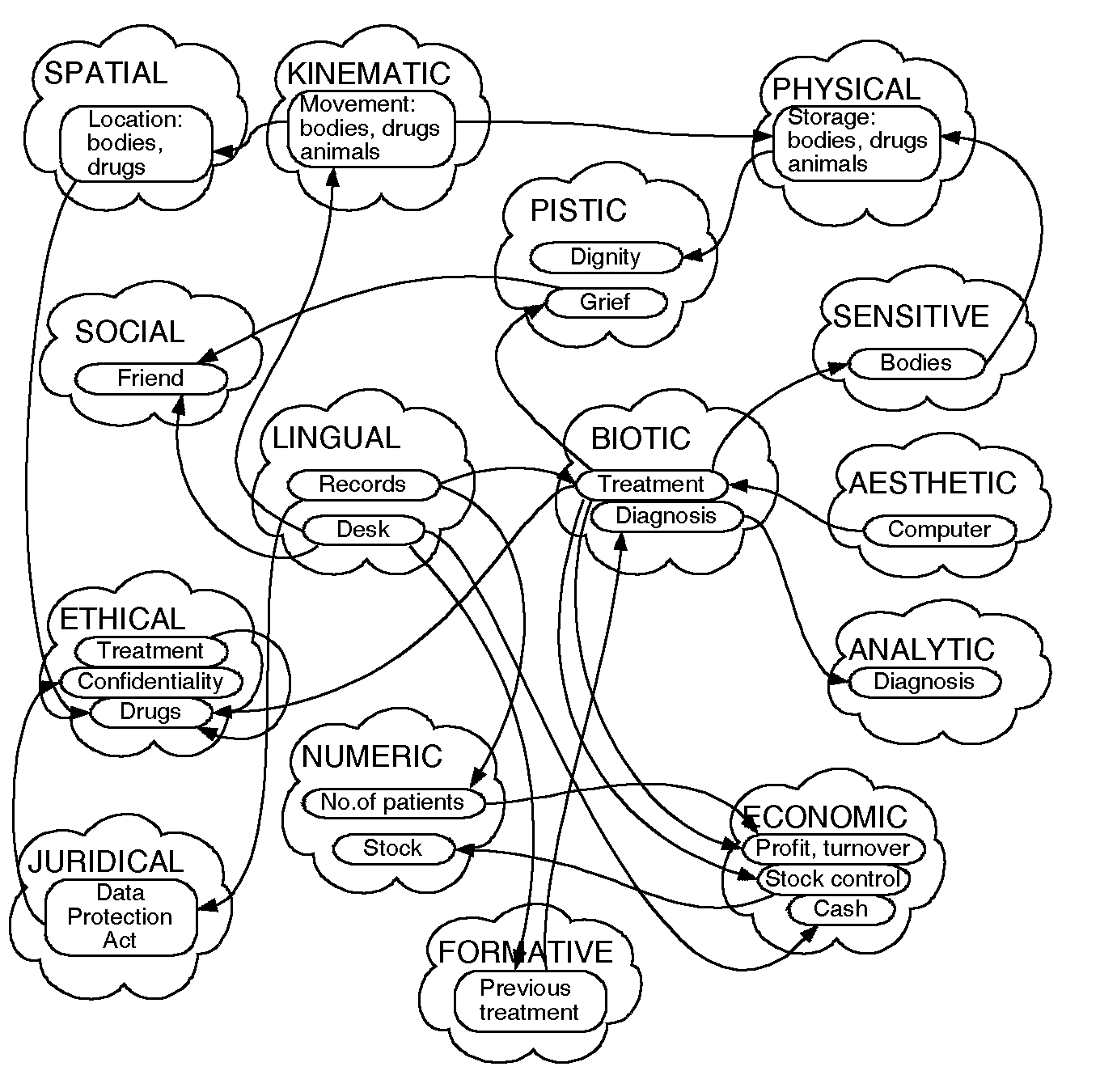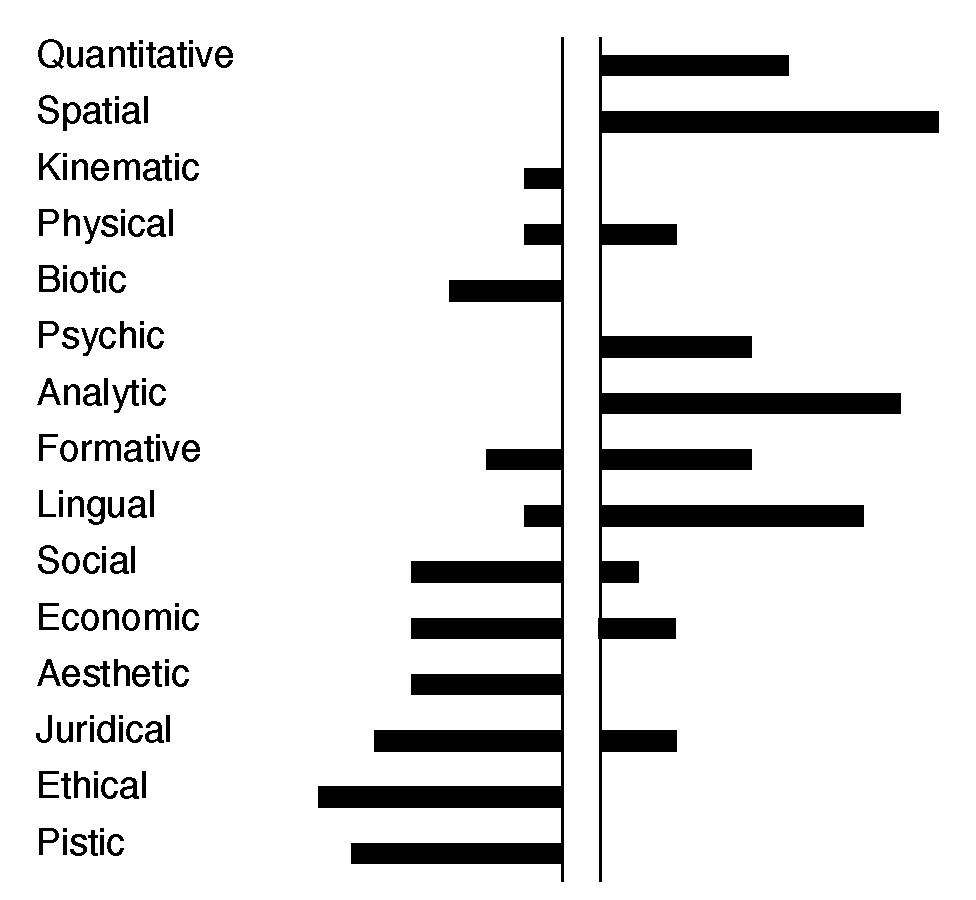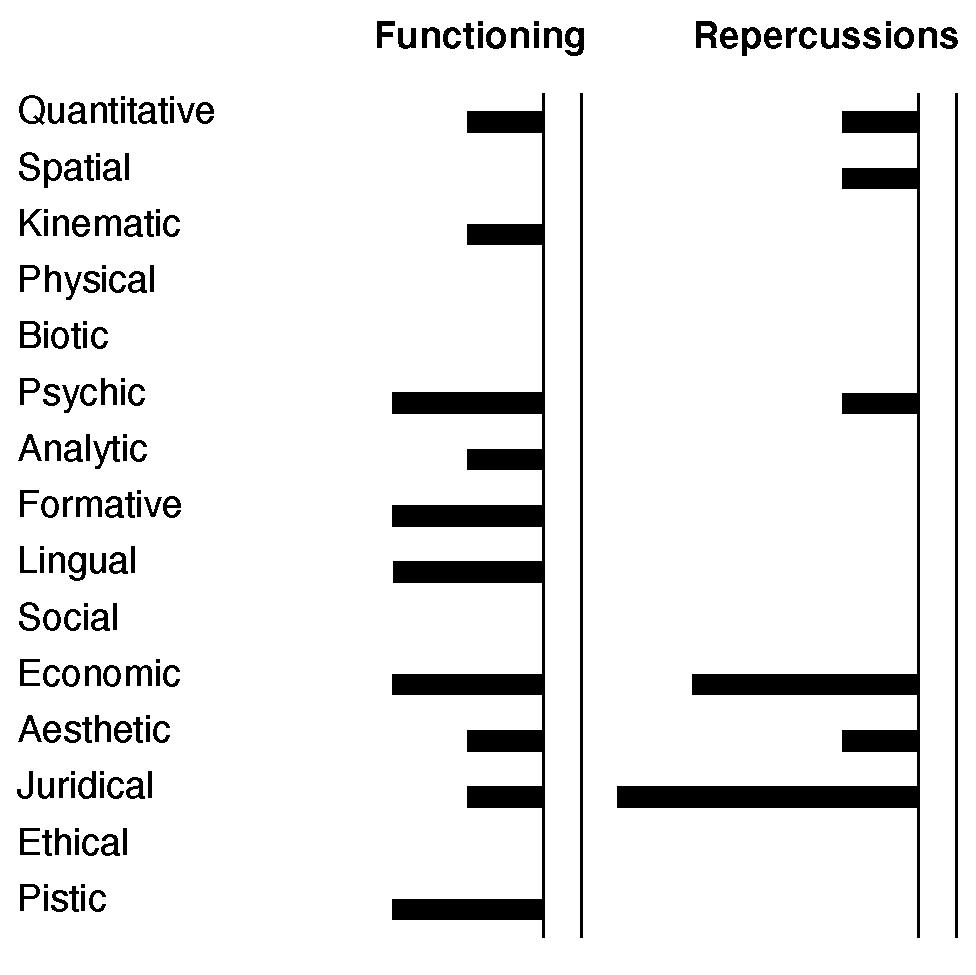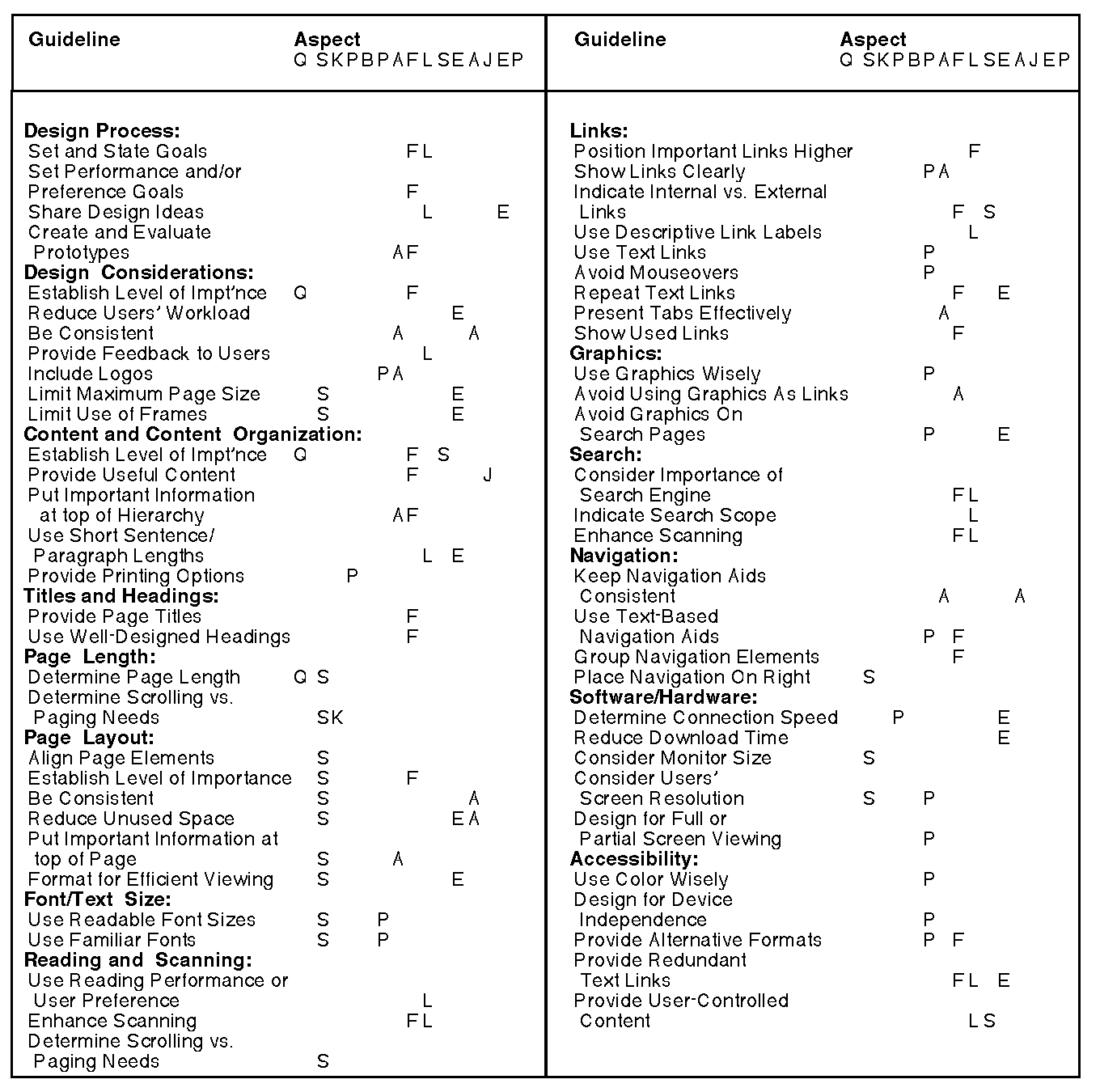 >
>
All things are situations and all human activity are multi-aspectual in nature. Aspectual analysis helps us escape from not only the reductionism of focusing on one aspect, but also from the black-and-white thinking that sees nothing other than the opposition between two aspects (for example capitalism-versus-socialism).
See examples of multi-aspectual situation. Dooyeweerd's aspects can account for the complexity of everyday living. But how can we analyse this complexity without diminishing it or overlooking things that are important? This page looks at types of aspectual analysis and ways of expressing the results. There are several things we might wish to do:
The 'something' might be a concrete situation or thing, or it might be a general thing such as a set of guidelines or a theory. To do these, there are several types of things we can express in terms of aspects.
Examples may be found on the following pages;
Analyse the thing, examining every aspect of it. Use the aspects to guide your thinking about it. Analysis can proceed in three ways:
However, in practice, one tends to cycle round and come back to others. And even for 1 and 2 you might begin not with the terminal aspects, but one of those near them, e.g. instead of the pistic, you might begin with juridical or ethical.
Which to use, and when?
However, I think the most useful types of analysis I undertake are not so structured as those. Rather, I find myself sensitive to forgotten or non-obvious or overlooked aspects. For example, the child's playground at Castle Park, Frodsham has a small wooded area one side. Suppose we were to ask mothers why they like the playground. They would probably mention safety, and the range of equipment available. They might also say something general about 'nice surroundings'. But they probably would not mention the wooded area s such. But my intuition tells me that the biotic aspect of the trees is more important than we might expect. This would lead me to ask a specific question to expose this aspect, such as "Suppose that instead of trees there was a concrete wall; would you still come so often?" A leading question, perhaps, but one designed to uncover a specific aspect. I would not ask about the aspect as such, and might not even think about it as an aspect, but I would simply be aware of things that exhibited the overlooked aspect and ask about them.
To understand a thing or situation aspectually, collect statements about each aspect of the thing, and then look at the whole picture. There are various ways of doing this.
This might involve an analysis of text. For example, Mitev [2001] discussed the failure that was the early SNCF (the French national railways) Socrate rail ticketing system:
"Technical malfunctions, political pressure, poor management, unions and user resistance led to an inadequate and to some extent chaotic implementation. Staff training was inadequate and did not prepare salespeople to face tariff inconsistencies and ticketing problems. The user interface was designed using the airlines logic and was not user-friendly. The new ticket proved unacceptable to customers. Public relations failed to prepare the public to such a dramatic change. The inadequate database information on timetable and routes of trains, inaccurate fare information, and unavailability of ticket exchange capabilities caused major problems for the SNCF sales force and customers alike. Impossible reservations on some trains, inappropriate prices and wrong train connections led to large queues of irate customers in all major stations. Booked tickets were for non-existent trains whilst other trains ran empty, railway unions went on strike, and passengers' associations sued SNCF."
Each phrase seems to be of a certain aspect, e.g. "sued SNCF" is juridical. If we collect these, then we can distribute phrases among the aspects as follows:
| Aspect | Phrases from Mitev's report |
|---|---|
| Quant'ive | Large, all |
| Spatial | queues |
| Kinematic | timetable and routes of trains, wrong train connections |
| Physical | - |
| Biotic | - |
| Psychic | not user-friendly, unacceptable to customers, irate |
| Analytic | tariff inconsistencies, airlines logic, inadequate database information |
| Formative | Technical malfunctions, prepare salespeople, Impossible reservations |
| Lingual | inaccurate fare information, Staff training, Public relations failed, sales force |
| Social | the public, passenger associations |
| Economic | poor management, ticket exchange capabilities, customers, non-existent trains, trains ran empty, railway unions went on strike |
| Aesthetic | chaotic implementation, prepare the public to such a dramatic change |
| Juridical | political pressure, inadequate implementation, The user interface was designed using the airlines logic, inappropriate prices, Booked tickets, passengers' associations sued SNCF |
| Ethical | - |
| Pistic | unions and user resistance |
To undertake textual analysis, go through phrase by phrase or even word by word, on the grounds that each phrase or word is often there by deliberate human choice, whether that choice is conscious or not. (If a phrase gets in from sheer habit of using and repeating that phrase, then it is perhaps meaningless, and can be ignored.)
A variant on this is to collect quotations from a variety of sources.
Analysis of text is often a good way to learn and practise aspectual analysis. You need practise before you can undertake direct analysis, which we discuss next. However, once you have become practised, it is usually better to begin with direct analysis and use analysis of texts only afterwards; see below.
An alternative to this is to analyse something directly, rather than using texts. Maybe by observation or by interviewing. This too can provide a number of facts about the thing in each aspect. For example, an analysis of the Elsie expert system yielded:
| Aspect | Usage of Elsie |
|---|---|
| Quant'ive | Number of questions, Number of floors, Magnitude of cost. |
| Spatial | Shape, size of building, Determine whether building fits site. |
| Kinematic | Lifts, stairs. |
| Physical | Ground loadbearing capacity, Finger force on keyboard. |
| Biotic | Muscle exerts force; light activates retinal cells, Opening windows for fresh air:PsychicUsers feel good about Elsie. |
| Analytic | Clarify client requirements, Separated building elements, Shapes on screen as significant, e.g. as letters, digits |
| Formative | Flexibility of layout, functional quality, Developing specification for the building, User formulates answer with computer. |
| Lingual | Communicate with client, Explanations of questions, User understand the questions and give answers, |
| Social | Cultural meaning of the questions, Enhance relationship with client., Circulation space. |
| Economic | Work out how to reduce costs, Final cost, Resources of the UI, e.g. screen area, time waited for computation. Time taken to answer questions. |
| Aesthetic | Aesthetic-amenity quality, Harmony between surveyor and client., Style of UI. |
| Juridical | Knowledge of local byelaws, building regs, Does the UI do justice to info, users?, Do justice to client's real needs. |
| Ethical | Surveyors happy to sacrifice power as experts, A 'generous' UI that gives more than strictly necessary. |
| Pistic | Role change to partners with shared goal. |
Such tables express the multi-aspectual functioning that is the thing or situation. But they can be taken further; see below. However, before that, let us consider a different type of analysis, and also expanding.
A rather different method, developed by Mike Winfield, involves looking at concepts that are meaningful in various aspects and linking them together. This can yield an aspect map such as follows:
 >
>
Figure 1. Aspect map generated in Multi-Aspectual Knowledge Elicitation
The steps of the MAKE process may be seen as:
Low Level Abstraction was a concept that Winfield developed from the 1991 edition of Clouser [2005] and refers to becoming aware of the various aspectual properties of things yet without isolating them from the things themselves.
| Aspect | HCI of Elsie | ERC in Elsie | Elsie HLC |
|---|---|---|---|
| Quant'ive | Number of questions | Number of floors. | Find out cost of building. |
| Spatial | Spatial layout of the keys. | Shape, size of building. | Determine whether building fits site. |
| Kinematic | Movement of fingers to press keys. | Lifts, stairs. | - |
| Physical | Force on key; light emitted by screen phosphor on retina; elecl-chem activity in brain. | Ground loadbearing capacity. | - |
| Biotic / Organic | Muscle protoplasm exerts force; retinal cells activate with light. | Fresh air: opening windows. | - |
| Psychic / Sensitive | Nerve signals from retina/cochlea to brain, to fingers, within brain to recognise and remember patterns. | - | Users feel good about Elsie |
| Analytic | I distinguish shapes on screen as significant, e.g. as letters, digits, conceptualising and categorizing them. | Separated building elements. | Clarify client requirements. |
| Formative | User forms letters into words, questions, makes inferences, formulates answers. | Flexibility of layout, functional quality. | Develop specification for the building. |
| Lingual | I understand the questions and give answers. | Explanations of questions. | Communicate with client. |
| Social | Cultural meaning of the questions; Standardization of UI. | Circulation space. | Enhance relationship with client. |
| Economic | Resources of the UI, e.g. screen area, time waited for computation. | Final cost. | Work out how to reduce costs. |
| Aesthetic | Style of UI. | Aesthetic-amenity quality. | Harmony between surveyor and client. |
| Juridical | Does the UI do justice to info, users? | Knowledge of local byelaws, building regs. | Do justice to client's real needs. |
| Ethical | A 'generous' UI that gives more than strictly necessary | - | Surveyors happy to sacrifice power as experts. |
| Pistic | My vision of who I am as I interact: controller of computer. | - | Role change to partners with shared goal. |
Thus, as a result of undertaking aspectual analysis, we were enabled to detect something we might not have known before.
After the entire process of analysis is finished, then you can ask yourself:
Very often the answer is to proceed to critique.
So far we have sought to understand a thing. But to critique a thing, we need to go further, and interpret it relative to some normative standard.
Keep a mental note of which aspects the discussion covers. Be aware of which aspects are often overlooked, such as the latest aspects (some of aesthetic to pistic). Be aware of which aspects are often over-emphasised in western culture (economic, formative and analytic) or in anti-western culture (biotic, psychic, social).
How to present this? Can gently suggest which aspects are over- or under-emphasised, usually in terms of something meaningful in those aspects rather than naming the aspect itself. Often by means of a question, e.g. "Are we overlooking issues of justice here?"
Interpretation involves applying a normative standard. The aspects provide two normative standards:
Very often, if we ignore an aspect, then we also transgress its laws, so the two are intertwined.
Look at the lists of things in each aspect found during our analysis. Is there a lot more in some aspects than in others? For example, an analysis of Alexander's 'design patterns' shows:
Table 4. Aspectual spread of Alexander's patterns

Each number is a pattern that guides architects in designing a building, and three main things are considered: construction of the building, the building as something in which human life takes place, and the town in which it is situated. Balance can be considered in three parts:
In this case we have analysed a set of guidelines, and then it is usually best simply to look at aspectual balance. But when analysing concrete situations, we can take aspectual norms into account.
Taking the normativity into account, and differentiating good from bad, is often more useful when analysing concrete situations rather than guidelines. Each aspect has norms. For example, according to the juridical aspect, justice is good, injustice is bad. The norms of the aspects are summarised in the following table.
| Aspect | Dysfunction |
|---|---|
| Biotic / Organic | Disease |
| Psychic / Sensitive | Emotional instability |
| Analytic | Confusion |
| Formative | Laziness |
| Lingual | Lying |
| Social | Hatred, disrespect |
| Economic | Waste, squandering |
| Aesthetic | Boredom, Ugliness |
| Juridical | Injustice |
| Ethical | Selfishness, self-centredness |
| Pistic | Idolatry, disloyalty |
An analysis of aspectual normativity of a situation would look at the ways in which the situation exhibits either good or bad in each aspect. Note that this helps us cope with things that exhibit both good an bad characteristics, such as something that is beautiful and yet unjust, or just and yet ugly.
A useful visual device that helps in such normative analysis is known as the aspectual fir tree, in which the amount of positive and negative functioning in each aspect is shown by the length of two bars, negative to left, positive to right:

Figure 2. Fir tree of aspectual repercussions
This (totally fictitious tree) could represent the use of a geographic information system. It shows major benefits in the spatial aspect (obviously!), the analytical (helping us clarify where we are) and the lingual (e.g. helping us communicate our position). But there might be dis-benefits in the ethical aspect (e.g. making the user selfish), pistic (e.g. user tends to focus too much on location and this reduces their loyalty to others), the juridical (... and they overlook the rights of others). Notice how in some aspects there are both benefits and dis-benefits.
But, as a pseudo-numerical device, the aspect tree can give an over-simplified picture if we are not careful. The following guidelines should be noted:
In this way, the aspect tree device is not an end in itself so much as a stimulant to focus further analysis, which could be carried out using Winfield's MAKE method, described below.
It can sometimes be useful to separate out aspectual functioning from aspectual repercussions, in two such fir trees side by side. For example, for Mitev's description of the Socrate failure, we can make a simple count of the number of times each aspect is referred to (as expressed by the phrases in the quoted text), either as a functioning or as a repercussion. We obtain the chart illustrated in Figure 4-4.

Figure 3. Aspectual view of Socrate failure
Even though only a single paragraph has been analysed -- and so this picture will be grossly misleading -- several things become clear: that this failure involved negative functioning in many aspects, not just the technical (formative), that the aspects in which the significant negative repercussions occur might not be those in which the negative functioning occurs, and that the most serious repercussions (that Mitev was interested in) were in the juridical aspect. That Mitev was not aware of Dooyeweerd's aspects, but merely adopted a lifeworld stance, is testimony to the power of this approach.
The aspect tree device may be used for both retrospective analysis, as here, or prospective analysis, during design or prediction. It may be a single tree, showing either functioning or repercussions or both together, as in Fig. 4-3, or one in which functioning and repercussions are separated, as in Fig. 4-4.
This follows critique. If we know what is wrong, then we can make suggestions for how to correct that - without sacrificing that which is already OK. We can make aspectual suggestions based either on balance or on aspectual normativity.
If we detect imbalance, i.e. an ignored aspect, then the obvious thing is to draw attention to that aspect, and make proposals for giving it due consideration. There are at least three kinds of suggestion we can make (with an example relating to the ethical aspect):
which is appropriate depends on the situation.
(Extract from 'Philosophical Frameworks for Understanding Information Systems', Basden [2007], IGI Global.)
All aspects have normativity (even the deterministic ones). This normativity offers a basis for establishing sound practical guidelines for developing or evaluating UIs or whole computer systems. The shalom principle of simultaneous realization of norms emphasises the importance of attending to each aspect. While it is appropriate on occasion to focus attention on one aspect (usually the qualifying) we should always do so in a way that gives all the other aspects their due. If we over-emphasise an aspect, and in the extreme absolutize it, we begin to ignore other aspects, and the result is that the success or fruitfulness of our activity is jeopardised. Thus, for example, a web page that has superb graphics but is otherwise devoid of useful content it will fall into disuse.
Web pages are user interfaces, and we can see the normativity of many of the aspects recognised in the more mature published web design guidelines. Table 6 shows the 'Research-Based Web Design and Usability Guidelines' of the National Cancer Institute [2005] and the main aspects of each guideline (aspects indicated by the first letter of their name, from Q = Quantitative to P = Pistic). Many have two aspects, sometimes because they cover two things (e.g. "set goals" (formative) and "state goals" (lingual)) and sometimes because the main idea is of two aspects (e.g. sharing is both lingual and ethical). We do not differentiate between qualifying and founding aspects here, but could do if a more precise analysis were needed.
Table 6. Aspects of Web Design Guidelines

We can use aspectual analysis as a basis for critique. The first thing that strikes us is how many aspects are represented here. This is, of course, what one would expect from a good, mature set of guidelines such as the NCI guidelines are. Second, we might look for imbalance among the aspects. The spatial and formative aspects appear more often than most other aspects; we can ask ourselves whether this is appropriate. Perhaps more significant are some gaps, at least in this 2005 version, some of which are quite surprising:
This aspectual analysis of these guidelines is not meant primarily as a criticism of the guidelines, which are excellent when compared with many others that are available, but rather to show how aspectual analysis can be useful as an evaluation tool, and how it might be used to suggest future improvements.
Andrew Basden, 23 November 2007.
All diagrams and tables copyright (c) Andrew Basden, 2007.
This page, "http://dooy.info/using/aspanal.html", is part of a collection that discusses application of Herman Dooyeweerd's ideas, within The Dooyeweerd Pages, which explain, explore and discuss Dooyeweerd's interesting philosophy. Email questions or comments are welcome.
Written on the Amiga and Protext in the style of classic HTML.
You may use this material subject to conditions. Compiled by Andrew Basden.
Created: 23 November 2007 Last updated: 1 December 2007 added some experience from H.I.'s analysis. 8 May 2008 Intuition about overlooked aspects. 16 December 2008 Halo effect, plus new section on dangers. 4 August 2009 links to maf, examples/maspl. 5 May 2020 new intro, new .end, .nav. 23 December 2021 link to eval.inst; canon.